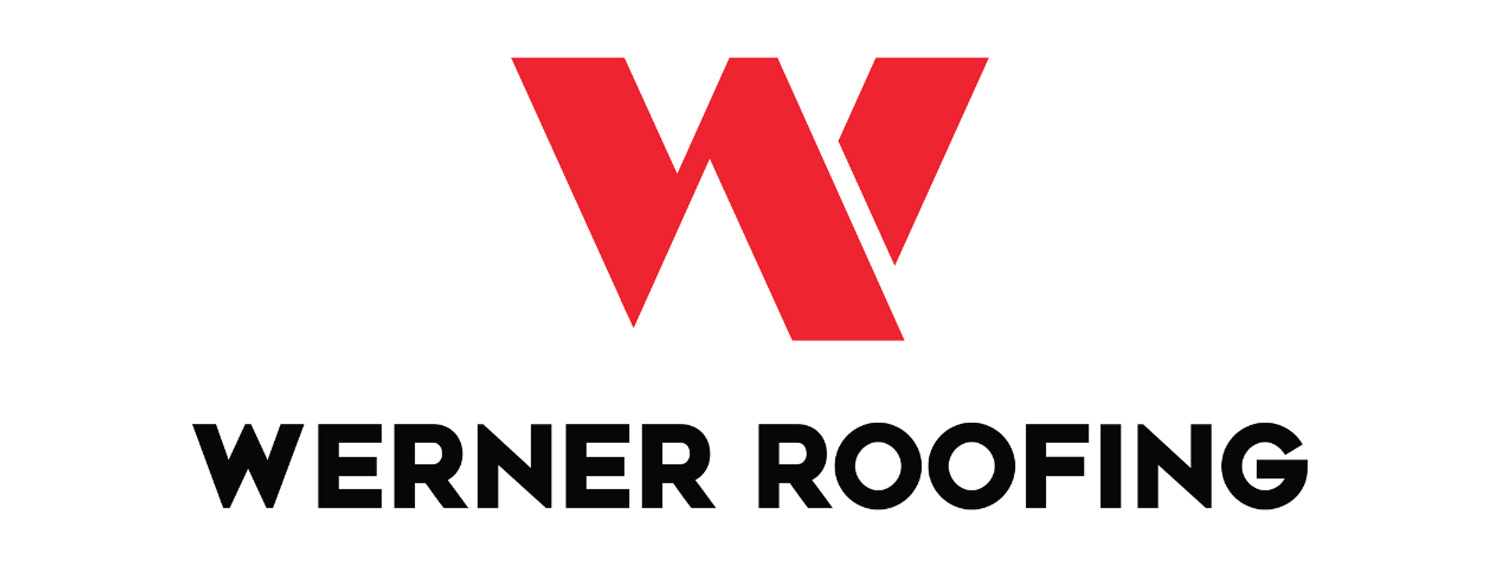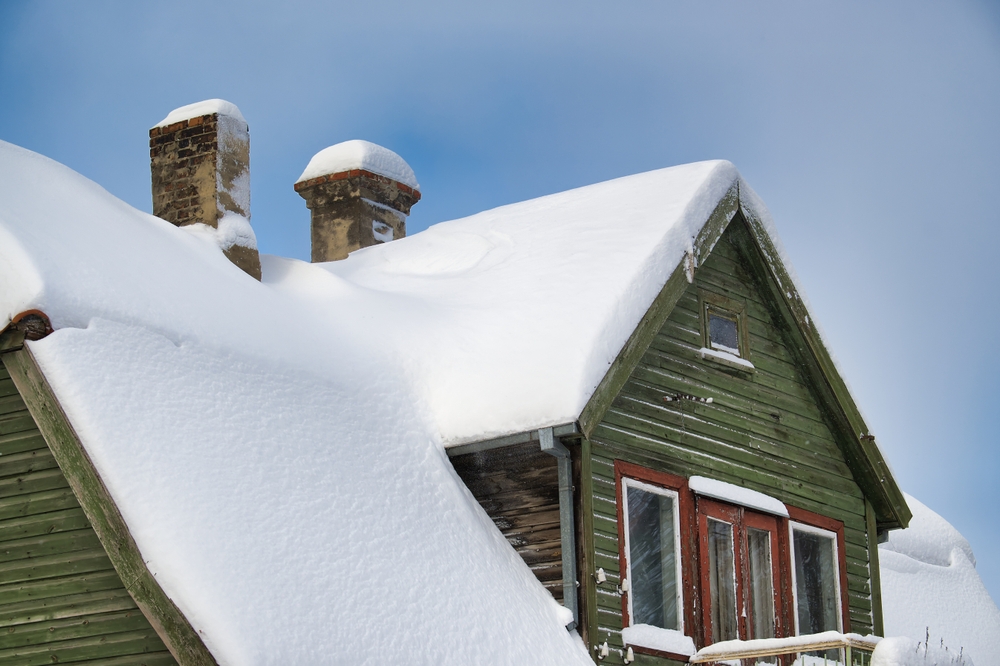
by Werner-Admin | Nov 6, 2025 | Roof Maintenance, West Michigan Roofing Blog
West Michigan winter storms are no joke. Between heavy lake-effect snow, freezing temperatures, and unpredictable storms, your roof takes on a lot during the year’s coldest months.
In fact, the average snowfall is approximately 77.6 inches in Grand Rapids, 87.2 inches in Muskegon, and between 80-95 inches in the lakeshore area.
Without proper maintenance, all that ice and snow can lead to leaks, ice dams, or even structural damage—problems that only get more expensive as winter wears on.
The good news? A little preparation and ongoing care can go a long way.
With proper winter roof maintenance, you can protect your home, extend the life of your roof, and avoid those last-minute emergency repairs when the next storm rolls in.
In this guide, we’ll walk through six simple but effective roof maintenance tips for Michigan homeowners. You’ll learn how to prevent ice dams, safely remove snow, and spot early warning signs of damage before they become serious issues.
6 Winter Roof Maintenance Tips
1. Inspect Your Roof Before the Snow Hits
One of the smartest things you can do before winter storms arrive is schedule a professional roof inspection. Once snow and ice build up, even minor wear and tear can become major problems.
A licensed roofer can spot issues that are easy to miss from the ground, such as:
- Loose, cracked, or missing shingles
- Damaged flashing around chimneys, vents, or skylights
- Weak spots or sagging areas
- Signs of poor attic insulation or ventilation
Catching these problems early helps prevent leaks, ice dam formation, and costly repairs. Plus, a clean bill of health gives you peace of mind knowing your roof is ready for whatever West Michigan weather brings.
If you’d rather not climb a ladder or deal with the cold, let the experts handle it. Werner Roofing offers free roof inspections to identify potential issues before they escalate, and we’ll never recommend a replacement unless it’s truly necessary.
2. Keep Gutters and Downspouts Clear
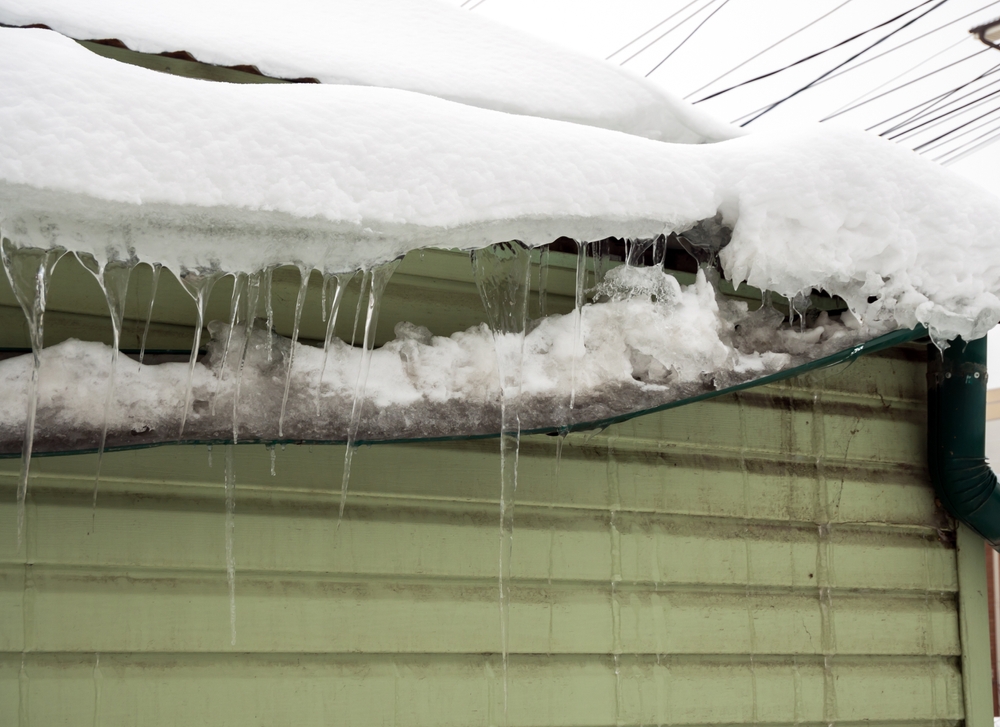
Your gutters play a huge role in keeping your roof healthy during winter. When they’re clogged with leaves, pine needles, or debris, melting snow has nowhere to go. Instead of draining correctly, it refreezes along your roof’s edge. This creates heavy ice dams that can lift shingles, damage gutters, and cause leaks inside your home.
To avoid that, make gutter maintenance part of your winter roof maintenance routine:
- Clean gutters and downspouts before the first freeze.
- Check for leaks or sagging sections that could trap water.
- Ensure downspouts direct water at least three to four feet from your foundation.
For long-term protection, consider installing a gutter guard system like LeafSlugger or GutterWorks, both available through Werner Roofing. These systems prevent debris buildup, allowing water to flow freely year-round (even in freezing temperatures).
3. Understand and Prevent Ice Dams
Few winter roofing issues cause more headaches for Michigan homeowners than ice dams. These thick ridges of ice form along the edges of your roof when heat from inside your home melts the snow on top. As that melted snow refreezes near the colder roof eaves, it traps water behind it, forcing it to back up under shingles and into your attic, walls, or ceilings.
Why Ice Dams Form:
- Inadequate attic insulation allows warm air to rise and melt snow unevenly.
- Poor ventilation prevents heat from escaping, creating warm and cold spots on the roof.
- Clogged gutters cause meltwater to pool and refreeze at the roof’s edge.
How to Prevent Ice Dams:
- Improve attic insulation to keep heat where it belongs (inside your home).
- Ensure proper ventilation to allow cold air to circulate under the roof deck.
- Seal attic air leaks around light fixtures, chimneys, and vents.
- Keep gutters clean so meltwater can drain freely.
If you notice icicles forming along your gutters, it could be an early warning sign of ice dams. The safest way to address it is to contact a professional roofer who can safely remove the buildup and help you correct the underlying cause.
4. Safely Remove Excess Snow From Your Roof

A little snow on your roof is perfectly normal in West Michigan. But when multiple storms pile up, that snow can become surprisingly heavy. The extra weight puts stress on your roof structure, especially on older homes or roofs with existing weak spots.
So, should you remove snow from your roof?
In most cases, yes—especially if you see more than six inches of accumulation or notice uneven snow buildup. Regular snow removal helps prevent:
- Roof collapse or sagging from heavy weight
- Ice dam formation caused by the melting and refreezing of snow
- Water damage from trapped moisture
How to Remove Snow Safely:
- Use a long-handled roof rake to pull snow down from the ground.
- Focus on clearing the roof edges and valleys where snow builds up.
- Avoid using shovels, hammers, or other tools that could damage shingles.
- Never chip away at ice — this can cause serious harm to both you and your roof.
Most importantly, don’t climb onto an icy roof. It’s simply not worth the risk. If your roof is steep or multi-story, call a professional.
5. Watch for Warning Signs of Roof Damage
Even with regular maintenance, winter weather can still take a toll on your roof. The key is catching problems early before they turn into leaks or major issues. Keep an eye out for these warning signs of winter roof damage:
- Water stains on ceilings, walls, or in your attic — a telltale sign of moisture intrusion.
- Large icicles hanging from the eaves or gutters — often a symptom of ice dams or poor insulation.
- Sagging or creaking areas on your roof — which could indicate excessive snow load.
- Uneven snow melt — warmer patches on the roof might point to heat escaping through insulation gaps.
- Drafts or temperature fluctuations in upper rooms — possible signs of attic ventilation issues.
If you notice any of these red flags, don’t wait until spring. Winter damage only worsens as freeze-thaw cycles continue. A quick inspection or repair now can save you thousands in future costs and keep your home safe and dry through the rest of the season.
6. Know When to Call the Professionals
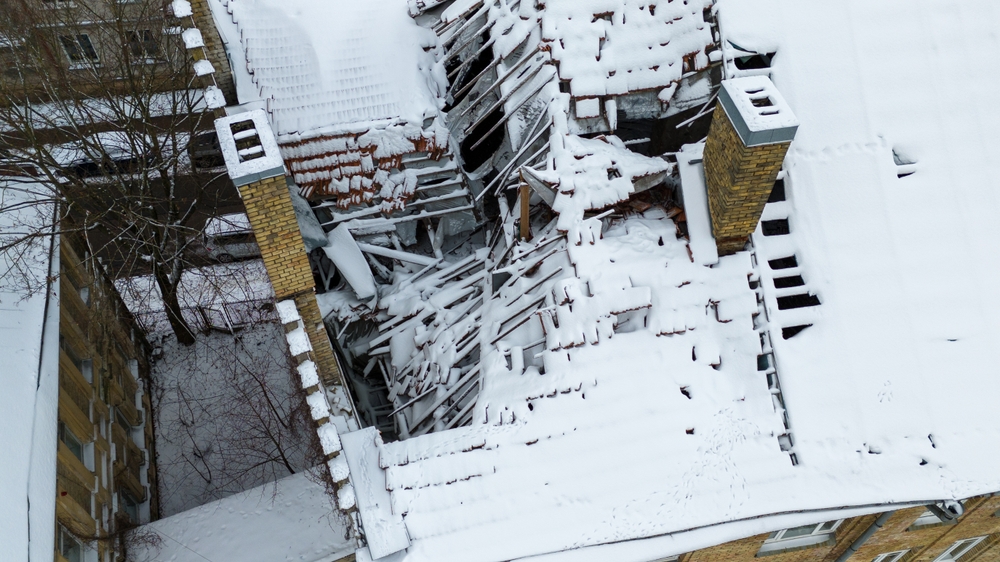
Sometimes, even the most diligent homeowners need a little help. Climbing icy ladders, removing roof snow, or diagnosing hidden leaks can be dangerous to do correctly, especially in the middle of a West Michigan winter.
If you notice persistent leaks, large ice dams, or sagging roof sections, it’s best to call a professional roofing company. The right team will address the immediate issue safely and uncover the root cause, whether it’s insulation, ventilation, or age-related wear.
At Werner Roofing, we’re here to make sure your roof performs its best all winter long. Our expert team can handle everything from snow removal and ice dam prevention to roof inspections and repairs, always with honesty and transparency.
Our promise: “We won’t recommend or sell a roof replacement unless it’s necessary.”
So, whether you’re worried about a small leak or just want peace of mind before the next storm, we’re ready to help.
Don’t Let Winter Catch Your Roof Off Guard
Your roof is your home’s first line of defense against West Michigan’s harsh winter weather, and a little care goes a long way toward keeping it strong. By inspecting your roof early, cleaning your gutters, preventing ice dams, and removing snow safely, you can avoid costly repairs and enjoy a worry-free winter.
But remember: you don’t have to do it all yourself.
The experts at Werner Roofing are here to help with inspections, maintenance, and repairs to keep your roof performing at its best all season long.
Don’t wait until melting snow reveals a hidden leak or spring thaw exposes damage. With help from your local roofing professionals, you can stay ahead of the weather and protect your investment.
Schedule Your Free Winter Roof Inspection Today
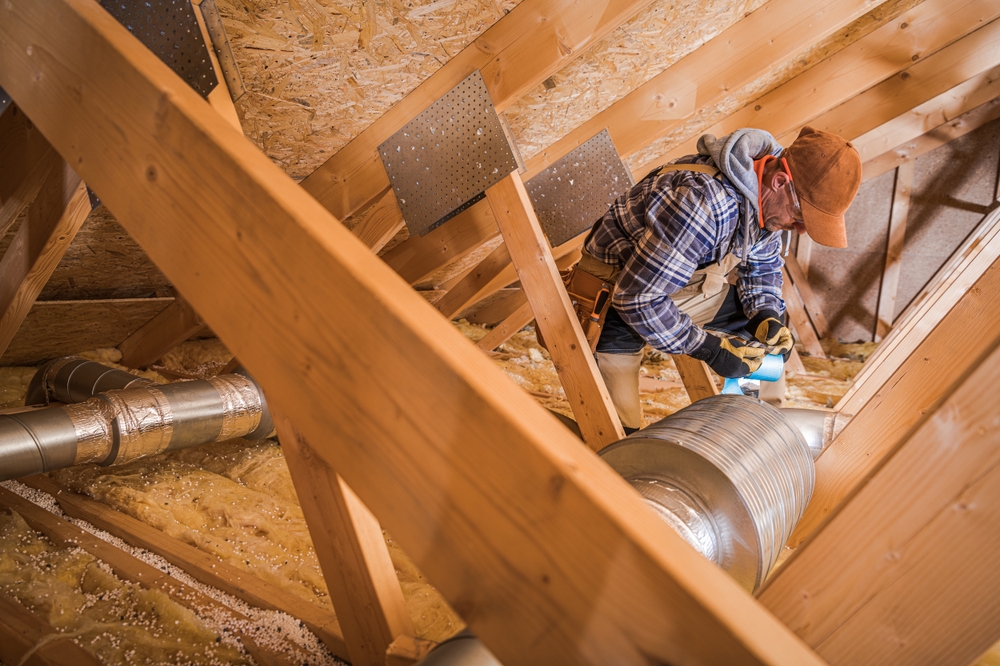
by elise@evenbound.com | Jun 26, 2025 | Roof Maintenance, West Michigan Roofing Blog
When most homeowners think about their roofs, they picture shingles, gutters, or maybe even flashing, but rarely ventilation. But proper roof ventilation plays a critical role in your home’s overall health, comfort, and efficiency. It helps regulate temperature, prevent moisture buildup, and even extend the lifespan of your roofing materials. Without efficient roof ventilation, you could face costly energy bills, mold problems, and premature roof failure.
Let’s discuss why roof ventilation matters, the different types of roof ventilators available, and how to tell if your current system is underperforming. Whether you’re building a new home or maintaining an existing one, this guide will help you understand how a well-ventilated roof protects your investment.
Looking for more attic-specific guidance? Check out our complete guide to attic ventilation.
Why Is Roof Ventilation So Important?
Roof ventilation isn’t just a nice-to-have feature — it’s essential for protecting your home year-round. When air flows properly through the attic and under the roof deck, it keeps your home cooler in the summer, drier in the winter, and more energy efficient overall.
Here’s how:
- Prevents heat buildup in summer
On hot days, heat can get trapped in your attic, making the rest of your home harder to cool. Proper roof ventilation allows hot air to escape, keeping your attic (and whole house) at a more manageable temperature.
- Reduces moisture accumulation in winter
In colder months, warm indoor air can rise into the attic and condense on cold surfaces, leading to moisture problems like mold, mildew, and rot. Good ventilation helps move that moist air out before it causes damage.
- Helps HVAC systems run more efficiently
When your attic isn’t overheating or holding excess moisture, your heating and cooling systems don’t have to work as hard, which lowers your energy bills and reduces wear and tear on your HVAC unit.
- Extends the life of roofing materials
Trapped heat and moisture can break down shingles, warp decking, and weaken underlayment. With proper airflow, your roof stays dry and cool, helping materials last longer and reducing the need for costly repairs.
The Cost- and Health-Saving Benefits
Proper roof ventilation isn’t just about comfort — it can save you serious money and protect your health. A well-ventilated roof can lower energy costs, reduce repair needs, and help prevent mold growth that can trigger respiratory issues. It’s a simple upgrade that pays off in the long run, both for your wallet and well-being.
5 Common Roof Ventilation Types
A balanced roof ventilation system includes intake vents, which draw cooler air into the attic, and exhaust vents, which allow warm, moist air to escape. Together, they promote continuous airflow that protects your home from damage and improves energy efficiency.
Here are five common types of roof ventilators used in residential homes:
1. Ridge Vents (Exhaust)
Ridge vents are installed along the peak of the roof and allow hot air to escape naturally from the attic. Since heat rises, these vents are highly effective at promoting continuous airflow without the need for moving parts or electricity.
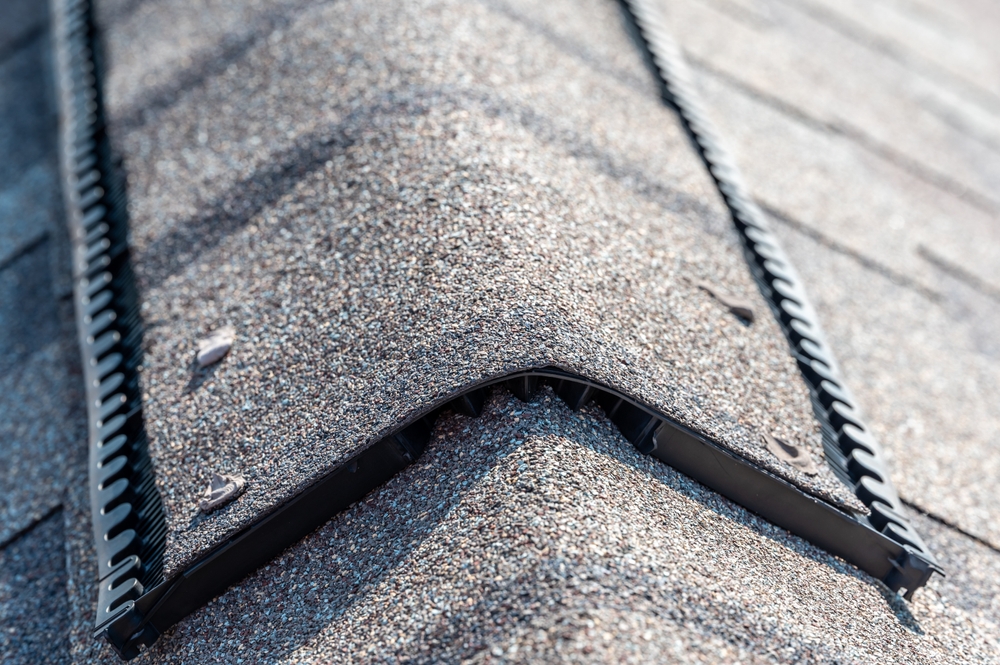
2. Soffit Vents (Intake)
Located under the eaves of your roof, soffit vents allow cool, outside air to enter the attic. When paired with ridge or other exhaust vents, they help maintain steady air flow through the space.
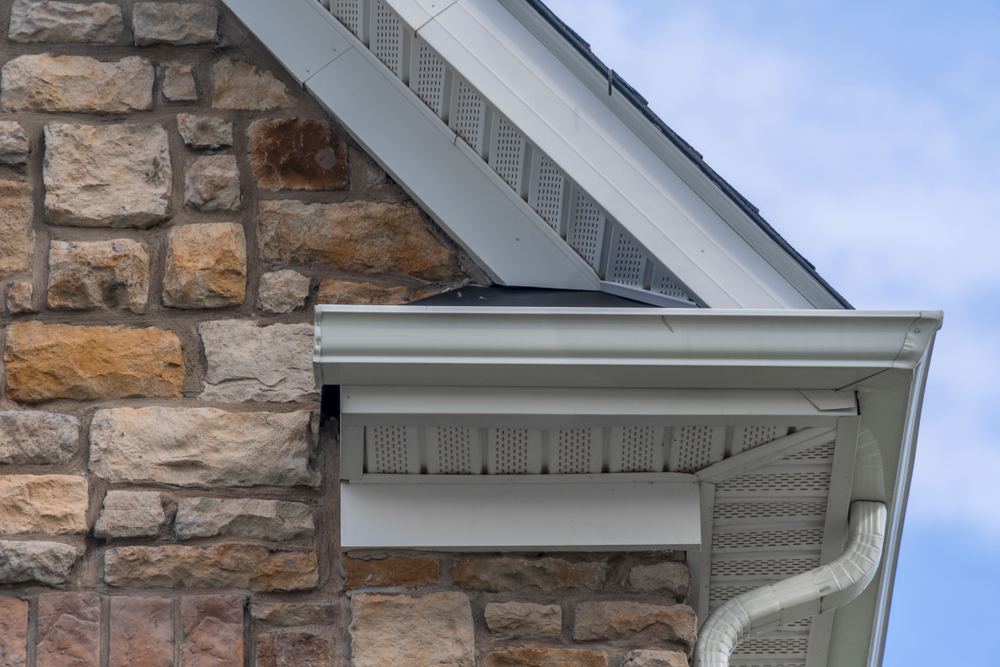
3. Gable Vents (Exhaust)
Gable vents are placed on the exterior walls near the peaks of gabled roofs. They allow warm air to exit and assist with cross-ventilation, especially in combination with other vent types.
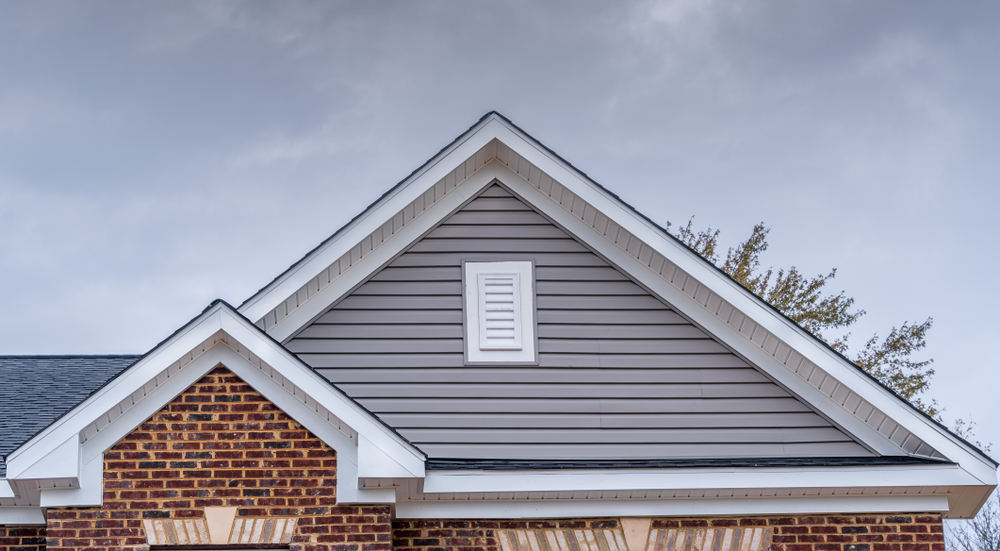
4. Roof Ventilation Fans (Exhaust)
Also known as powered attic ventilators, these electric or solar-powered fans actively pull hot, humid air out of the attic. They’re especially useful in areas with extreme heat or poor natural airflow, though they do require energy to operate.
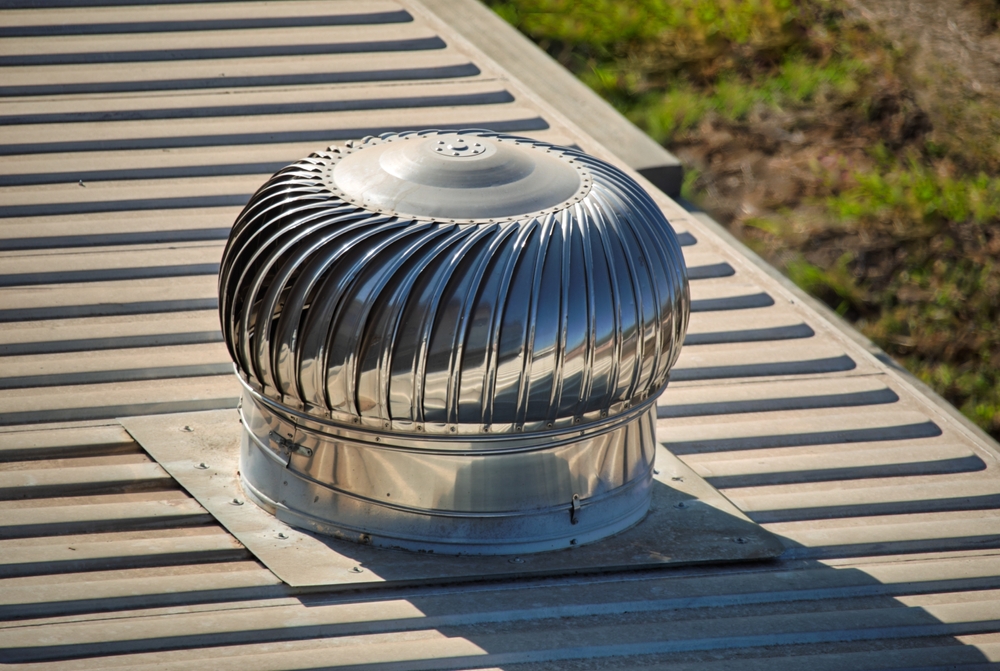
5. Box or Turtle Vents (Exhaust)
These are small, static vents typically placed near the roof ridge. They allow hot air to passively rise and escape. While simple, they can be effective when installed in the correct quantity and paired with proper intake vents.
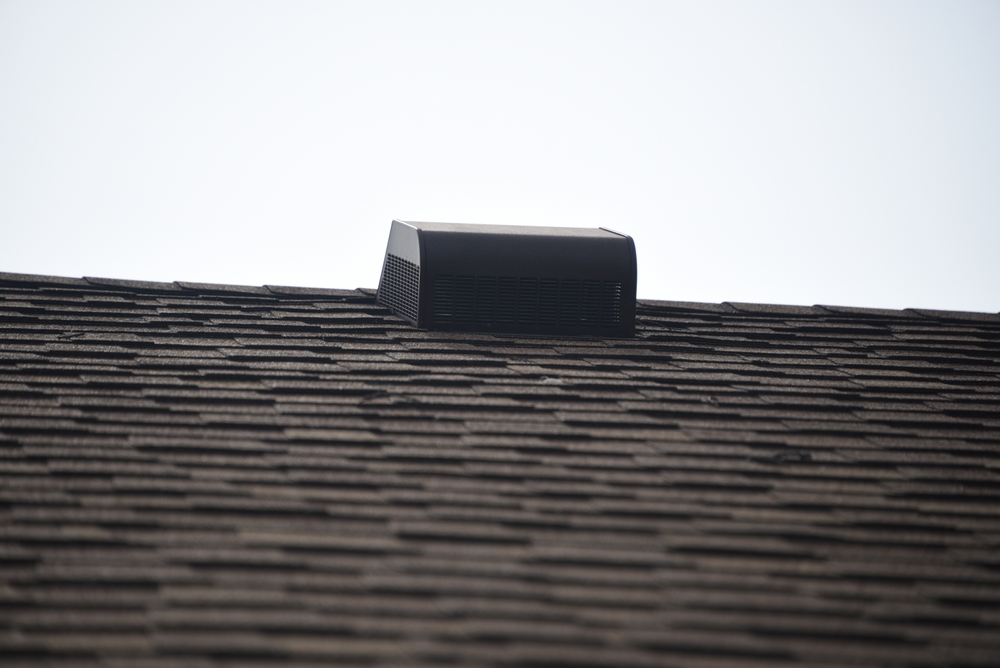
How to Know If Your Home Has Poor Roof Ventilation
Not sure if your home’s roof ventilation is doing its job? Poor ventilation often flies under the radar until it causes noticeable (and costly) problems.
Here are some common warning signs to watch for:
- Uneven temperatures throughout the home
If some rooms are noticeably hotter or colder than others, especially on upper floors, it could be a sign that your attic isn’t properly ventilated.
- High energy bills
Poor airflow can cause your HVAC system to work overtime, especially in the summer and winter. If your energy bills seem unusually high, inefficient ventilation could be to blame.
- Ice dams in winter
Warm air trapped in the attic can melt snow on the roof, which then refreezes at the eaves, forming damaging ice dams. Proper ventilation helps regulate attic temperature to prevent this.
- Mold or mildew in the attic
Excess moisture in the attic creates the perfect environment for mold and mildew growth, which can pose serious health risks and damage insulation and wood structures.
- Premature roof wear
Curling shingles, deteriorating underlayment, or rotting roof decking can all be signs that your roof is retaining too much heat and moisture.
When to Call In a Professional
If you’ve noticed any of these issues or just want peace of mind, schedule a professional roof inspection. At Werner Roofing, we’ll evaluate your home’s ventilation system and recommend the best solutions to protect your roof and improve your home’s energy efficiency.
How Werner Roofing Can Help
We understand that roof ventilation is one of the most critical and often overlooked components of a healthy roofing system. Our team has years of experience identifying, installing, and upgrading all types of roof ventilation systems, from ridge vents and soffit vents to powered roof ventilation fans.
If you’re unsure whether your ventilation system is working properly, don’t leave it to guesswork. Ask Werner Roofing for a professional roof inspection and expert recommendations tailored to your home. We’ll help you find the best ventilation solution for long-term comfort and protection.
Ready to Improve Your Roof Ventilation?
Roof ventilation may not be the first thing that comes to mind when you think about home maintenance, but it plays a major role in keeping your home comfortable, energy-efficient, and protected from damage.
If you think your ventilation system isn’t doing the job, don’t wait for problems to show up. Contact Werner Roofing today for a professional roof inspection and expert solutions that keep your home safe, efficient, and built to last.

by Werner-Admin | May 13, 2025 | Skylights, West Michigan Roofing Blog
When you think about skylights, the first thing that probably comes to mind is the beautiful natural light they let shine into your home. But skylights offer more than just aesthetics; they also support a greener, more energy-efficient lifestyle.
Whether you’re looking to lower your energy bills, reduce your carbon footprint, or create a healthier living space, skylights deliver impressive eco-friendly advantages. We’ll break down the top five environmental benefits of a skylight and why installing one (or a few!) could be smart.
5 Best Benefits of a Skylight in Your Home
1. Reduce Energy Use With Natural Light
One of the most significant benefits of a skylight in your home is how much natural light it brings in. More daylight means less need for lamps and overhead lights, helping you minimize electricity use, lower energy bills, and shrink your carbon footprint.
- According to the U.S. Department of Energy, installing ENERGY STAR® certified skylights can reduce energy bills by an average of up to 13% on heating and cooling costs nationwide
Modern skylight designs offer plenty of flexibility. If you don’t have space for a full-sized skylight, smaller options like the Velux Sun Tunnel® Skylight make it easy to brighten closets, hallways, bathrooms, and other hard-to-reach spaces.
No matter the size of your home, there’s a skylight solution that can help you bring in more natural light and make a positive impact on the environment.
2. Lower Heating and Cooling Demands
Another benefit of a skylight is its ability to help naturally regulate your house’s temperature. In cooler months, an energy-efficient skylight can allow passive solar heat to warm your living space, reducing the need to run your furnace.
In warmer months, venting skylights can release hot air that rises to the ceiling, helping you keep your home cooler without overworking your air conditioner.
Here are a few tips to maximize your skylight’s energy efficiency:
- Choose a skylight with the ENERGY STAR® label to ensure it meets energy efficiency standards.
- Work with a professional installer to ensure proper flashing, sealing, and placement.
- Consider glazing options like low-emissivity (Low-E) coatings to further improve insulation.
It’s a common myth that skylights automatically cause energy loss. With modern designs and expert installation, the opposite is true. A properly installed, high-quality skylight can help your environment stay comfortable year-round while reducing energy use.

3. Improve Indoor Air Quality With Venting Options
Skylights don’t just let light in; some are designed to allow stale air out. Venting skylights can open to release warm, humid, or stuffy air naturally rising to the ceiling, improving your home’s overall air circulation.
Better ventilation in your house means:
- Less reliance on air conditioning to keep your home cool.
- Reduced indoor pollutants, allergens, and moisture buildup.
- Healthier air quality, especially in kitchens, bathrooms, and other high-humidity areas.
4. Support Mental and Physical Health
Natural light can also boost your mood, energy levels, and overall well-being. Studies have shown that increased exposure to daylight can even improve sleep quality by helping regulate your circadian rhythm. As a result, you’ll experience boosted productivity, focus, and creativity. Natural sunlight can also reduce symptoms of anxiety and depression.
Skylights create a healthier indoor environment by filling your home with more natural light, which supports mental and physical health. When people feel better, they tend to live more sustainably, making choices that benefit their homes, communities, and the planet.
5. Sustainable Materials and Long-Term Efficiency
Modern skylights are designed with sustainability in mind, utilizing advanced materials and technologies that enhance both environmental performance and durability.
Key features of sustainable skylights include:
- Low-Emissivity (Low-E) Glass: This specialized glass coating minimizes heat transfer, helping to keep your home warmer in winter and cooler in summer. It also blocks up to 95% of harmful UV rays, protecting your furnishings from fading.
- Argon Gas Fill: Many skylights feature dual-pane glass filled with argon gas, which provides superior insulation compared to air and reduces energy loss.
- Durable Construction: High-quality skylights are built to withstand the elements, often featuring laminated glass that resists impact and reduces noise, ensuring longevity and safety.
Homeowners can enjoy long-term energy savings and contribute to a healthier environment by choosing skylights with these sustainable features.

Bring the Benefits of Skylights to Life With Werner Roofing
At Werner Roofing, we’re proud to be the only certified installer of Velux Skylights along the West Michigan lakeshore. That means when you work with us, you get the best of the best — both in products and installation expertise.
Why Velux Skylights?
- ENERGY STAR® certified: Most Velux models meet or exceed ENERGY STAR® requirements for energy efficiency.
- Sustainable design: Velux is committed to using responsibly sourced materials and manufacturing processes that reduce environmental impact.
- Variety of options: From traditional skylights to innovative solutions like the Velux Sun Tunnel® Skylight, there’s a model for every space and style.
When installed by our experienced team, Velux skylights deliver all the environmental benefits you want. Are you ready to bring more natural light and energy savings into your home?
It’s Time To Enjoy the Benefits of a Skylight in Your Home
Skylights do more than brighten your home — they help create a more energy-efficient, sustainable space for you and your family. From reducing electricity use to improving air quality and boosting your wellbeing, the environmental benefits of a skylight are hard to beat.
If you’re ready to make your home brighter, greener, and more beautiful, the team at Werner Roofing is here to help. Contact us today to learn more about Velux skylight options or to schedule your free consultation!
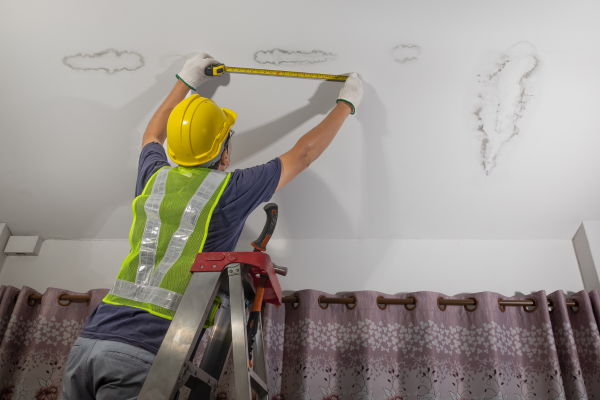
by Werner-Admin | Oct 6, 2024 | Roof Replacement, West Michigan Roofing Blog
Sometimes, it’s hard to tell if you need a new roof until it’s too late. You may not know the severity of the situation until your roof starts leaking or serious damage occurs. This can cost you way more money in the long run.
The first place you may see signs you need a new roof is where you spend the most time—inside your home.
Here are a few telltale signs you may see inside that it may be time to consider upgrading your roof.
5 Warning Signs You Need a New Roof
Is your roof starting to show signs of wear and tear? Here are five warning signs you need a new roof, or at least a repair.
1. The Roof Deck Is Sagging
The underlying structure of your roof is called the “roof deck.” The roof deck plays a crucial role in keeping your roof stable. If you have a vaulted ceiling or can access your attic, look here for signs of sagging.
A sagging roof deck is a strong indicator of water damage. This could result from leaks, impact from a fallen tree branch, or other external forces.
Over time, this can weaken the structure and compromise the integrity of your roof entirely. Fixing this as soon as possible can prevent costly structural repairs down the line.
2. You Notice Signs of Water Damage or Leaking
Water stains on your ceiling or walls are telltale signs that moisture is seeping through your roof.
You might notice yellow, brown, or even blackish discolorations in areas where water has been absorbed into your drywall. In more severe cases, you may see active drips or leaks during rainstorms.
If this is happening to you, don’t immediately panic. Minor leaks can usually be easily repaired.
However, extensive water damage often means a new roof is necessary to protect your home’s interior from ongoing water intrusion and prevent mold growth.
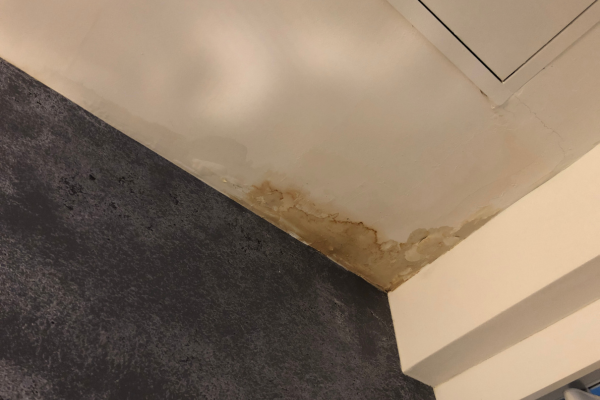
3. Outside Light Is Showing Through the Roof
As you can imagine, it’s a bad sign if you can see outside light coming into your home and it’s not through a window or skylight. It’s a sign that your roof has holes or gaps, leaving it vulnerable.
Gaps in roof boards can allow rain, snow, and even pests into your home, leading to damage that can spread quickly. Even a tiny gap can worsen over time, and a roof replacement is usually the best way to restore complete protection and insulation to your home.
4. There Is Mold or Mildew Growth Around Roof Penetrations
If you notice mold or mildew growing in your attic or near vents, pipes, or other roof penetrations, this can be a sign of poor ventilation or water leaks.
Mold thrives in moist environments, so even the smallest small leak can go undetected and create ideal conditions for growth.
Mold is not only a structural threat but can also pose health risks to you and your family, so it isn’t something to take lightly.
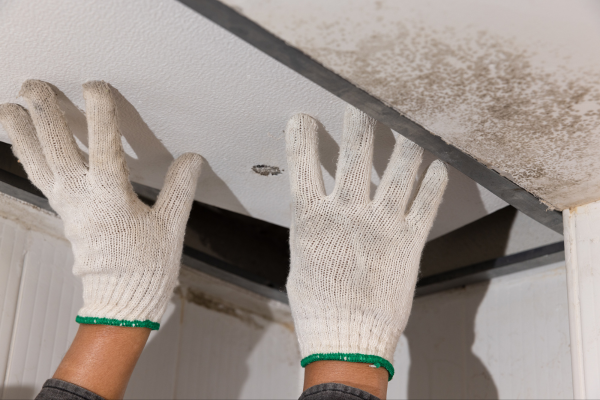
5. You’ve Seen a Spike in Your Energy Bills
A sudden increase in energy bills can indicate poor insulation or a leaking roof. This results in warm air escaping during winter and cold air seeping out in the summer.
When this happens, it forces your HVAC system to work harder to maintain a comfortable temperature in your home, which costs more money.
Check your attic for signs of drafty spots or poor insulation, indicating a compromised roof. Replacing your roof can help seal up these leaks, keeping your home more energy-efficient and reducing your monthly utility costs.
Don’t Wait on Roof Repairs: Contact Werner Roofing for a Free Inspection Today
Replacing an old, damaged roof can eliminate this issue and prevent mold growth by creating a better-sealed and ventilated space.
Now that you know the warning signs you need a new roof, you can keep your home in the best shape possible.
If you notice any of the above issues, addressing them early can help you avoid more extensive—and costly—repairs in the future.
At Werner Roofing, we’re here to help with all your roofing needs. Our team of experienced roofing professionals can assess your roof’s condition and provide a free, no-obligation estimate to ensure your home stays safe, dry, and energy-efficient.
Call Werner Roofing today at (616) 844-5382, or visit us online to schedule your inspection. Let us help you protect your biggest investment—your home.

by Werner-Admin | Sep 27, 2024 | West Michigan Roofing Blog
Proper roof maintenance is important no matter the time of year. However, with fall fast approaching, it’s important to ensure that your roof is ready to handle the snowy winter months ahead.
Don’t know where to start? Check out the following roof maintenance tips that you can implement this fall.
5 Roof Maintenance Tips for the Fall Season
Maintaining your roof during the fall season is essential to protecting your home and preparing for the harsher weather. Taking proactive steps now will help extend the life of your roof and ensure it’s ready to handle the winter months.
1. Trim Surrounding Trees
No one wants to wake up to a hole in their roof with a big tree branch sticking through. Ensuring that there are no dead tree limbs, large branches, or trees leaning toward your house can prevent disaster later down the road.
The extra weight of the snow could cause dead or dying limbs or trees to fall onto the house, causing a costly repair. Removing overhanging branches from your home will also reduce leaf buildup and the chance of rot or excessive leaves in your gutter system.
2. Clean Gutters
Cleaning your gutters regularly during the fall is one of the most crucial tasks for maintaining your home’s exterior. As the leaves fall, your gutters can quickly become clogged with debris, leading to serious issues if not addressed in time.
Leaves and debris can cause water to back up, preventing proper drainage through your gutter system. This excess water can overflow and seep under your shingles when left unattended, causing roof damage.
Worse yet, if the temperatures drop and the water freezes, it can expand, leading to cracks or breaks in both your gutters and roof structure. Preventative cleaning can save you from costly repairs down the line!

3. Schedule a Roof Inspection
One of the smartest moves you can make this fall is to schedule a professional roof inspection. An experienced roofer can identify minor issues that need attention before they become costly problems.
During the inspection, they’ll assess the overall integrity of your roof, looking for signs of leaks, missing or loose shingles, and damaged gutters. Catching these small repairs early not only helps extend the life of your roof but also saves you from more expensive fixes in the future.
Don’t wait until a minor issue becomes a major headache—schedule your inspection with Werner Roofing today!
4. Check for Loose or Missing Shingles
Loose or missing shingles may seem insignificant, but they can lead to serious damage if left unchecked. Shingles are your roof’s first line of defense against the elements, and when they’re damaged or missing, your home becomes vulnerable to water leaks, mold growth, and even structural damage in your attic, walls, and ceilings.
Regularly checking for loose or missing shingles during the fall season helps you stay ahead of minor repairs and prevents more expensive damage down the line. After storms or high winds, it’s especially important to check for signs of damage. Look for visible gaps, shingles that appear curled or cracked, or areas where the roof looks uneven. These are all indicators that shingles may be loose or missing and need to be replaced.
If you notice something is wrong with your roof’s shingles, it’s best to call a professional roofer. They can safely inspect your roof and replace any damaged shingles. They’ll also ensure new shingles are properly installed, keeping your roof protected from further damage.
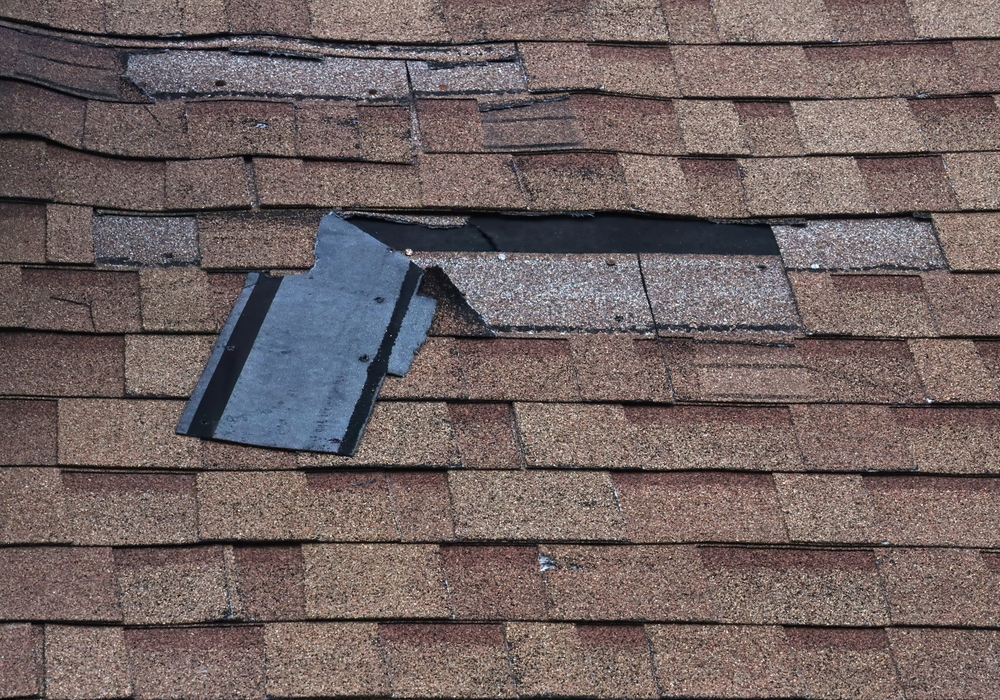
5. Ensure Proper Attic Ventilation
Attic ventilation is critical to maintaining the health of your roof and home, especially as temperatures drop in the fall. Proper ventilation allows air to circulate freely in your attic, which helps regulate temperature and moisture levels. Without it, warm air inside your home can become trapped, leading to condensation, mold growth, and even ice dams in the winter.
Poor attic ventilation can also reduce your roof’s lifespan. Excess heat and moisture can warp shingles, damage the roof decking, and lead to premature aging of the materials. Ensuring proper ventilation can prevent these issues and help your roof last longer.
To check your attic ventilation, look for blockages in your intake vents (usually located near the roof’s eaves) or exhaust vents (located along the ridge or in gable ends). If the vents are clogged with debris, it’s essential to clear them to ensure proper airflow. You can also have a professional assess your attic ventilation system to determine if it’s adequate for your home’s size and needs.
Get Your Roof Fall-Ready: Contact Werner Roofing for an Inspection Today
For peace of mind and professional expertise, call Werner Roofing today. Our experienced team is here to assist with all your roofing needs, from inspections and repairs to full roof replacements. Schedule your fall roof inspection now, and let us help you keep your home safe and secure throughout the season.

by Ben Johnson | Jan 15, 2024 | Roof Maintenance, Roof Repair, West Michigan Roofing Blog
Finding the right person to install a new roof on your home isn’t always easy. Roofing can be a major expense, so it’s crucial to make sure you choose the right roofing contractor to do the job. Do you know what you should look for in a good roofing contractor and roofing proposal? If not, don’t worry – we’re here to help!
Our Guide to Roofing Proposals
As a homeowner, collecting bids from several roofing contractors and choosing the best fit for your preferred budget, materials, and timeframe is helpful. To select the option that’s best for you, though, you need to know a little about understanding roofing contractor proposals.
Let’s break down the roofing proposal process so you know exactly what to look at and how to tell which roofing contractor is the best choice for your home.
What Info to Provide for a Roofing Proposal:
First things first – before a contractor can create a proper proposal, they’ll need some information from you first.
- Budget – You’ll need to tell potential roofers how much you’re willing to spend on your new roof. Though you might not have a specific number in mind yet, do a little research to see what is reasonable for the material you’re looking for and the size of your home to give potential contractors a ballpark figure to start with.
- Preferred Material – Are you looking for a metal roof? Asphalt? Or something different, like ceramic tile? Whatever aesthetic you’re going for, you’ll want to let your roofer in on it so they can create a proposal that reflects the end goal. Remember that different materials, finishes, and colors have varying price points.
- Timeframe – Do you need your roof completed by a specific time? If you’re building a new home, the time frame will be essential because you’ll have to have a roof installed before moving on to interior construction. The timeframe may be more flexible if you’re re-roofing an existing home.
- Description of any Current Problems – Any reputable roofer will inspect your roof before they give you a final estimate. If there are any issues you know about beforehand, you’ll want to share this with potential roofers. Then, they can put the price of those additional fixes into their proposal, giving you a fair look at how much you’ll be spending.
Once you’ve given roofers a basic idea of what you’re looking for in your roofing project, they’ll assemble a proposal and send it to you. The proposal should outline everything the roofer plans to do, when they plan to do it, and how much it will cost.
What to Look For in a High-Quality Roofing Proposal:
When evaluating roofing proposals, knowing what exactly you should be looking for is crucial. Let’s dive in!
- Materials Used – The roofer should include exactly which roofing materials they plan on using, including the name of the manufacturer, the style of the shingle, and the grade of the material. This will allow you to compare multiple proposals and better understand what quality to expect from each roofer.
- Scheduling – A roofing proposal should also include a detailed schedule of when everything will happen. Most roofing jobs shouldn’t take that long, but they are inconvenient for those who live in the home, so it’s important to know when roofers will be there and how long it will take them to finish the job.
- Explanation of Liabilities – A quality roofing proposal should explain any potential liabilities and how the roofer’s insurance will cover those liabilities in the event of an accident. This will tell you what insurance the roofer has. If they don’t have insurance, you’re liable for any injury on your property, and it’s possible your roof won’t comply with the local building code.
- How Waste Will be Removed – Roofing is a messy job. Nails and shingles are flying everywhere! You need to ensure that whoever you hire has a plan to clean that mess up before they leave, and the proposal should state how they plan to clean up. Many roofers have a giant magnet that picks up any fallen nails, and others make sure to throw all old shingles and waste into a giant dumpster they provide. No matter the method, make sure they offer clean-up, or you may end up paying a lot more.
At Werner Roofing, we prioritize minimizing debris on your property. So, we’ve made significant investments in using tools like the Equipter to keep your home relatively free of debris during the roof replacement process. Learn more about our roofing process here!
- Explanation of Warranty – Roofs often have multiple warranties. There’s a warranty on materials and another on the work the roofer and crew complete. The proposal should outline the specifics of each warranty and explain what is covered under each warranty.
- How the Roof Will be Paid For – A quality proposal outlines what you must pay and when. Some roofers take payment in installments, while others prefer part up front and the second part when the work is completed.
- Additional Costs – If there are any additional costs associated with your roofing job (repairing subroofing, installing flashing around the chimney, etc.), the proposal should also outline those.
Things to Double-Check Roofing Proposals For:
While everything on a roofing proposal is important, there are a few things you’ll want to double-check for. Remember that a quality roofer should already include these items. A shadier roofer might leave them out to get your business and charge you more later.
- Itemized List of Costs – Not every roofer offers an itemized list of costs automatically, but if you’re comparing bids, it’s a good thing to ask for. An itemized list tells you exactly what you’re paying for each aspect of your roof, from labor to material costs.
- Licensure and Workers Compensation – Ensure that any roofer you hire is licensed and provides workers’ compensation to their crew members. This protects you from any liabilities that occur on your property.
- Acknowledge Regional Nuances – Be mindful of local regulations or variations that might impact the specifics of roofing proposals in your area. These guidelines can influence material choices, installation methods, or waste disposal practices, making it essential to ensure proposals align with local standards.
Understanding Proposals and Trusting Werner Roofing
In the end, when choosing a roofing contractor, read through each proposal thoroughly. The best roofing contractors will be as upfront as possible with cost estimates. They will have the necessary permits, licensing, and insurance to protect their crew and your home.
If the roofing proposals you’ve been looking at still don’t make sense, feel free to call Werner Roofing. We’ve been working in the area for decades and provide roofing services you can trust. For a free estimate, call our office at 616-844-5382 or request for a free roofing estimate online today!

